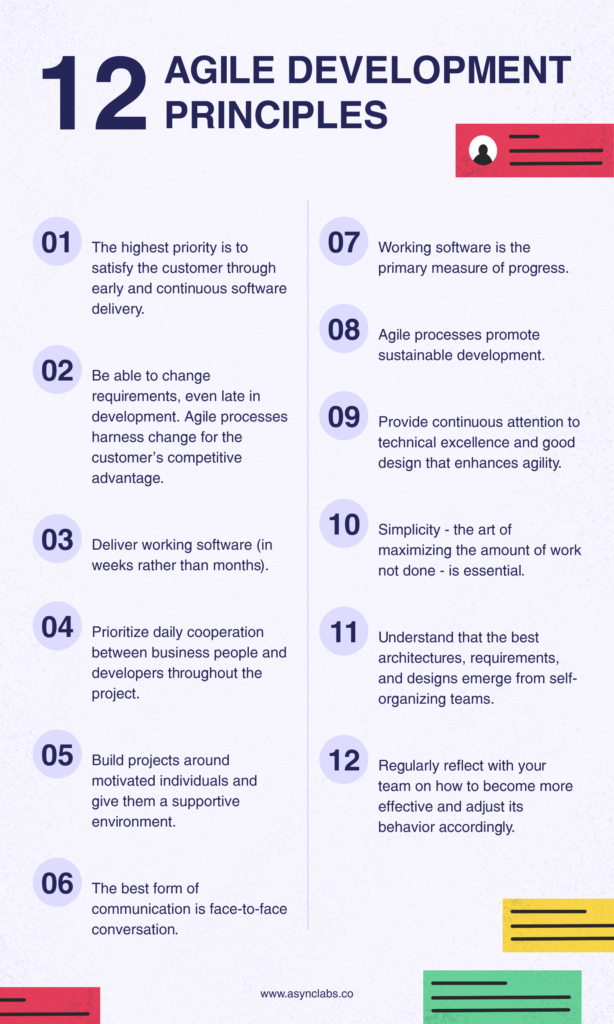Where classical methods have proved insufficient, agile product development comes to the rescue.
Quality project management is one of the most important pillars that help companies successfully implement the process and achieve the desired goals (delivery of products/services).
There are several different approaches to project management. Today, the agile way of project management is the prevailing trend in the software development world. Because it works for many various modern projects, there are many businesses doing something Agile these days.
Let’s find out what agile product development is, how it works, how it differs from traditional software development, and what sets it apart.
What is Agile Product Development?
If you want to do something fast, you have to be agile.
To better understand the Agile approach, it is essential to understand the Agile Manifesto, a document published in 2001 that describes the Agile project’s methodology, which changed the landscape of modern software development.
The main focus of agile methodology is to build a product correctly. Another agile focus involves shortening the feedback loop between the proposed requirement and the development team writing the functionality, and it helps the product evolve toward fulfilling requirements.
Here are the original twelve agile development principles that make software development more flexible, efficient, and fast:
- The highest priority is to satisfy the customer through early and continuous software delivery.
- Be able to change requirements, even late in development. Agile processes harness change for the customer’s competitive advantage.
- Deliver working software (in weeks rather than months).
- Prioritize daily cooperation between business people and developers throughout the project.
- Build projects around motivated individuals and give them a supportive environment.
- The best form of communication is face-to-face conversation.
- Working software is the primary measure of progress.
- Agile processes promote sustainable development.
- Provide continuous attention to technical excellence and good design that enhances agility.
- Simplicity (the art of maximizing the amount of work not done) is essential.
- Understand that the best architectures, requirements, and designs emerge from self-organizing teams.
- Regularly reflect with your team on how to become more effective and adjust its behavior accordingly.

How did Japanese manufacturing influence agile?
With its roots in the Japanese business philosophy, the agile way of project management is becoming a growing trend in project management and organizations’ overall business.
How has Toyota changed the way we make things? Its success is rooted in a unique system and began what is now known as Lean Manufacturing, an ethos emulated by companies worldwide to make products cheaper but better and faster.
After World War II, Japan was left in a precarious economic position. Already disadvantaged by lacking natural resources, materials were hard to come by, and companies had to be creative to compete. Toyota’s founder, Sakichi Toyoda, has started the whole business, but his son Kiichiro founded the motor company in 1937. As the shortage of materials increased, they needed to develop something that would improve the business.
As a part of this, machinist Taiichi Ohno developed a Kanban, a sign-based scheduling method related to lean manufacturing. To avoid mistakes, above every station, they placed a cord. This way, any worker could pull to stop the entire assembly if they spotted a problem. The whole team then worked on it to prevent it from happening again. As teams identified more issues, the number of errors began to drop dramatically.
This way, a brand became known for making reliable and affordable cars. Toyota’s production system changed how cars are made and our view on making things faster, improving efficiency by eliminating waste, and showing there is always a better way to make a quality product.
What approach do we use?
The Agile methodology is one of the most effective, practical, flexible, and successful mechanisms for software development that deliver values and drive your organization ahead. This framework has embraced several giant software companies worldwide to attain digital transformation, including us.
At Async Labs, we emphasize agility and adaptability and use the Scrum agile method. Iterative-incremental processes like Scrum enable us to deliver complex solutions and the highest values.
We are consistent in our scrum ceremonies, invest a lot of time in the development process, and approach it in a planned way. This way, we can quickly adapt to changes and client wishes.
Scrum is a framework in agile project management used to manage work on complex products. Teams complete tasks in a set period called sprints, with a daily analysis and progress assessment.
Why is Agile preferred over traditional project management?
In traditional software development, the customer is involved only at the beginning of the development process.
Agile process management allows the customer to get involved at every stage. This allows for greater team collaboration, creates more team interaction, helps save costs, and delivers superior results. Also, clients can better convey their idea, which can reduce the possibility of misunderstanding the project.
Since it follows a linear approach, the traditional method is the best fit for small or less complex projects. Sudden changes during the project can block the entire process and force the team to start from the beginning.
Agile methodology is a good fit for complex projects. A complex project may have various interconnected phases, where each stage depends on others.
The agile approach helps project teams to meet user needs better and ensure flexibility in uncertain environments. It implies organized collaboration of all participants and supports fast and efficient decision-making.
Traditional project management focuses on developing specifications first, which is strictly adhered to throughout all subsequent phases of the project. If there are any deviations, it is necessary to go back to the beginning of the project and redefine things.
Agile handles these changes better because the review is constantly done throughout the project, and delivery is immediately functional. For example, the client gets functionality that works within a month of starting the project.
With the traditional approach, the client receives delivery much later in the form of app/functionality. It is necessary to pass and complete all phases (e.g., specifications, design, development).
Main advantages of Agile product development
- Greater productivity, flexibility, and adaptability to change
- Faster problem detection
- Short-term goals and sprints are easier to manage and achieve results
- Better use of resources at lower cost (better ROI)
- Greater interaction with customers/clients
- More teamwork and more communication
Agile focuses on keeping the process lean and creating MVPs (minimum viable products) that go through several iterations before the final version. It is a much more dynamic process where everyone is working together towards one goal.
Critical agile product development practices
Collaborate with customers and understand their needs
Agile methodologies focus on delivering customer value quickly, meaning product managers must stay close to customers to understand their needs and wishes.
One of the principles of agility is early and frequently gathering feedback to ensure that the product brings the expected benefits to users.
When the requirements, expectations, wishes, and needs are met, we have a satisfied client. The Agile team constantly communicates with the client, works on corrections, clarifies expectations, and considers different options to deliver the best possible product.
Create the product roadmap
An agile roadmap is a near-term plan for achieving the product strategy that must be updated throughout the product life cycle. The purpose of a product roadmap is to document and communicate the high-level work and objectives of a product plan, showing progress and remaining work.
Sharing a product roadmap with your team and stakeholders will help keep everyone on the same page about the product’s overall vision, progress, and goals. It represents monthly or quarterly commitments and is adjusted regularly to accommodate change.
Prioritize features
Agile product management continuously prioritizes features for implementation. This includes defining user stories, maintaining the product backlog, defining user stories, and deciding what to build and when.
Product managers work closely with developers to define requirements, estimate features, and collaborate on a release plan based on the team’s capacity.
Agile team
When they perform at the highest level, Agile teams constantly learn and empower each other and create a motivating environment.
Agile teams are supportive, passionate about their work, and focused on the team goal. In a trustful and respectful environment, they establish a fast-paced and predictable work rhythm and bring extraordinary results.
Tips and tools for successful Agile product development
If you’re a product manager, you’re constantly conducting research and keeping an ear out for what customers want/need.
Product Management and agile seem to go hand in hand nowadays. But what happens if you get stuck on the same trajectory? Do you give up or keep going?
Here are some tips and tools you can always come back to if you get stuck during your following agile product development process.
- Talk a lot – communication between team members and with clients is crucial
- Plan your sprint carefully – you don’t want to overload the team or underperform
- Review the product all the time – you will detect all illogical things sooner
- Stick to the plan defined – continue to do everything you planned, even when it gets challenging
- Advise your client – clients aren’t always familiar with the best and latest practices
- Get a big picture of the project – do not blindly execute tasks; think about what you do
Tools we use:
- Figma – for crafting interfaces and collaborating on them
- Slack – for seamless communication within the team and with external stakeholders
- Discord – for video calls because nothing feels better than first thing in the early morning is seeing your remote colleagues 🙂
- Teamwork – collaborative tool for keeping your team members, collaborators, and clients in the loop and completing a task effectively and efficiently
Final thoughts
The methodology depends on the project and the client, but whenever you can choose – agile.
Today, applying the principles of agile product development means gaining an advantage over the competition. Practical, simple, and effective agile methods can be the engine of your future business success. Use them wisely and accelerate your business growth.
Like everything else in life, agile product development does not offer a universal path to success. It is just one way to respond to the ever-changing changes in your business. So, in the end, it is up to you to decide which one is best for your team.
At Async Labs, we help companies build and grow products by delivering high-quality software through agile practices. Have a brilliant product idea and want to transform it into inspiring reality? Let’s work together!
